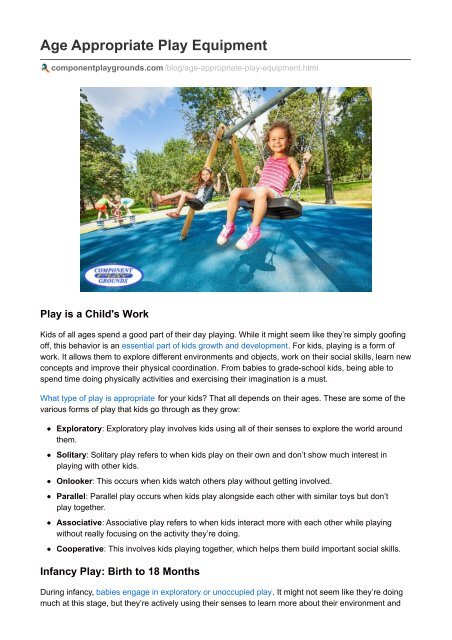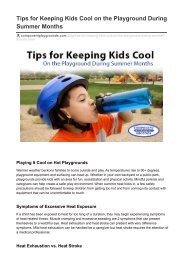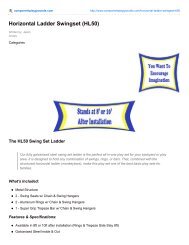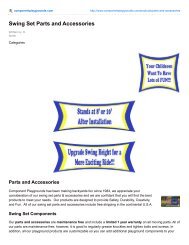Age Appropriate Play Equipment- Component Playgrounds
Kids of all ages spend a good part of their day playing. While it might seem like they’re simply goofing off, this behavior is an essential part of kids growth and development. For kids, playing is a form of work. It allows them to explore different environments and objects, work on their social skills, learn new concepts and improve their physical coordination. From babies to grade-school kids, being able to spend time doing physically activities and exercising their imagination is a must. What type of play is appropriate for your kids? That all depends on their ages. These are some of the various forms of play that kids go through as they grow. For more, visit: http://www.componentplaygrounds.com/
Kids of all ages spend a good part of their day playing. While it might seem like they’re simply goofing off, this behavior is an essential part of kids growth and development. For kids, playing is a form of work. It allows them to explore different environments and objects, work on their social skills, learn new concepts and improve their physical coordination. From babies to grade-school kids, being able to spend time doing physically activities and exercising their imagination is a must.
What type of play is appropriate for your kids? That all depends on their ages. These are some of the various forms of play that kids go through as they grow.
For more, visit: http://www.componentplaygrounds.com/
Create successful ePaper yourself
Turn your PDF publications into a flip-book with our unique Google optimized e-Paper software.
<strong>Age</strong> <strong>Appropriate</strong> <strong>Play</strong> <strong>Equipment</strong><br />
componentplaygrounds.com /blog/age-appropriate-play-equipment.html<br />
<strong>Play</strong> is a Child's Work<br />
Kids of all ages spend a good part of their day playing. While it might seem like they’re simply goofing<br />
off, this behavior is an essential part of kids growth and development. For kids, playing is a form of<br />
work. It allows them to explore different environments and objects, work on their social skills, learn new<br />
concepts and improve their physical coordination. From babies to grade-school kids, being able to<br />
spend time doing physically activities and exercising their imagination is a must.<br />
What type of play is appropriate for your kids? That all depends on their ages. These are some of the<br />
various forms of play that kids go through as they grow:<br />
Exploratory: Exploratory play involves kids using all of their senses to explore the world around<br />
them.<br />
Solitary: Solitary play refers to when kids play on their own and don’t show much interest in<br />
playing with other kids.<br />
Onlooker: This occurs when kids watch others play without getting involved.<br />
Parallel: Parallel play occurs when kids play alongside each other with similar toys but don’t<br />
play together.<br />
Associative: Associative play refers to when kids interact more with each other while playing<br />
without really focusing on the activity they’re doing.<br />
Cooperative: This involves kids playing together, which helps them build important social skills.<br />
Infancy <strong>Play</strong>: Birth to 18 Months<br />
During infancy, babies engage in exploratory or unoccupied play. It might not seem like they’re doing<br />
much at this stage, but they’re actively using their senses to learn more about their environment and
the objects around them. This is why babies often put toys and other items in their mouth. Babies also<br />
use their sense of touch to discover new textures, such as water or clay. Letting them handle a variety<br />
of objects helps them learn even more and allows them to begin working on their sensorimotor skills.<br />
To give your infant a chance to explore even more, consider putting her in a full bucket swing once<br />
she’s old enough to support herself while sitting up. She’ll have a great opportunity to take in all the<br />
sights, sounds, smells and textures of the outdoors while enjoying the fresh air. She should be old<br />
enough for this type of swing once she’s around 6 months old.<br />
Toddler <strong>Play</strong>: Early Childhood: 18 Months to 3 Years<br />
Once kids reach toddlerhood, they’re able to walk around on their own, which gives them more<br />
opportunities to play and explore. At this stage, kids are typically content to play on their own. This<br />
allows them to figure out how to use new toys and other items at their own pace. Toddlers also spend<br />
time watching other kids play, which helps them learn even more about how to use their hands to<br />
manipulate objects.<br />
Kids that are closer to 3 years of age typically spend more time doing parallel play near other kids. This<br />
gives them a chance to mimic what other kids are doing. They also start to use their imaginations more<br />
while playing, such as coming up with imaginary friends or pretending that they’re in a different place.<br />
You can give your toddler more time to develop his motor skills and work on coordination by having him<br />
go on playground slides designed for kids his age. You can also put him in half bucket swings when he<br />
outgrows full bucket ones in order to let him do more exploratory play.<br />
Preschooler <strong>Play</strong>: 3 to 5 Years<br />
Younger preschoolers spend a great deal of time engaging in associative play, which helps them get<br />
used to interacting with and speaking to other kids. As they get older, they begin spending more time<br />
playing with other kids in more focused activities, such as games or building things together. During<br />
this stage, kids also make leaps and bounds in terms of motor development and show more interest in<br />
outdoor activities that challenge them.<br />
To encourage your preschooler to enjoy outdoor activity, let her climb up and go down slides made for
younger kids. She can also practice walking and running on ramps and balancing on spring rockers. At<br />
this age, she can still use half bucket swings as well.<br />
School <strong>Age</strong> <strong>Play</strong>: 6 to 12 Years<br />
School age kids are full of energy and love being able to work on more developed physical skills, like<br />
climbing and jumping. They’re also finally able to move onto concrete operational play, which involves<br />
being able to use logic to think things through. This can help them stay safe and make better<br />
judgements when playing outdoors on various types of equipment.<br />
Your school age kid can enjoy a wide range of playground equipment, including flat seat swings, taller<br />
slides and monkey bars. Kids this age also love having different platforms and levels to run around on<br />
and explore on more elaborate swingsets.<br />
No matter what age your child is, making sure he has plenty of chances to play will help him develop<br />
physically, socially and emotionally. Giving him opportunities to put his skills to use outdoors on<br />
swingsets and other playground equipment has the added benefit of getting him out in the fresh air and<br />
sunshine while having fun.<br />
<strong>Play</strong>ground <strong>Equipment</strong> Salt Lake City<br />
Whether you’re looking for a simple starter swingset or one that combines a swingset and clubhouse,<br />
contact <strong>Component</strong> <strong>Play</strong>grounds. We sell a wide range of swingsets and other playground equipment<br />
for all ages.










